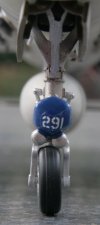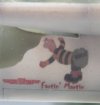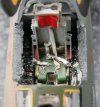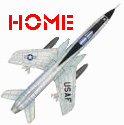Plastic Wings
Republic F-105G/F Thunderchief in triplo
13th TFS "Panther Pack" - 355th TFW Takhli RTAB mei 1966
357th TFS "Licking Dragons" - 355th TFW Takhli RTAB oktober 1968
17th WWS - 388th TFW Korat RTAB 1972
Klik de miniaturen voor een grotere afbeelding.
Het verhaal achter de drie Thuds
Deze drie Thunderchiefs stellen één en hetzelfde toestel (BuAir no 63-8291) voor, doch op verschillende tijdstippen in zijn
carrière. Ik gebruikte drie verschillende edities van dezelfde kit: eentje van Monogram (gekocht in 1984 tijdens mijn legerdienst
in Duitsland), later door Revell USA heruitgegeven en nog later heruitgebracht door Revell Duitsland.
Het toestel zonder witte letters op de staart stelt 291 voor in mei 1966, toen het als een gemodificeerde F-105F toegewezen was
aan het 13th TFS “Panther Pack”, 355th TFW te Takhli (Thailand) waar het onder meer met de Iron Hand missie belast was.
Soms wordt voor deze toestellen ook verkeerdelijk de verwijzing EF-105F gebruikt.
De Iron Hand missie behelst het onderdrukken en aanvallen van vijandelijke luchtdoelwapens zoals (al dan niet radargeleid)
geschut en luchtdoelraketten – de gevreesde SAM’s – waarvan de SA-2 Guideline in Vietnam vanaf 1965 meer en meer een bedreiging
vormde voor de Amerikaanse toestellen.
Later in de oorlog evolueerde de Iron Hand missie in de Wild Weasel missie. Wild Weasel was zowat de gevaarlijkste job waarvoor
je je als piloot kon opgeven: het was volgens de statistieken onmogelijk dat je 100 missies (het vereiste aantal om terug naar
de VS terug te kunnen keren) kon volmaken en men werd dan ook uitsuitend op vrijwillige basis Weasel. Toen deze missie aan de
eerste groep Weasel-piloten (die toen niet wisten waarvoor ze vrijwilliger waren) werd uitgeduid, was de reactie van één van hen
“You gotta be shittin’ me!” Vanaf de jaren 70 zag men dan ook vaak dit insigne op de piloten hun overall en op hun vliegtuig.
The story behind the three Thuds
These three Thunderchiefs depict one and the same aircraft (BuAir no 63-8291) in three different periods of its service life.
I used three editions of the same kit: one by Monogram (bought in 1984 during my military service in Germany), reissued later
by Revell USA and still later by Revell of Germany.
The aircraft without white tailcodes shows 291 in May 1966, when the modified F-105F was assigned to the 13th TFS "Panther Pack"
- 355th TFW stationed at Takhli RTAB in Thailand, where - amongst others - it flew the Iron Hand mission.
Sometimes these aircraft are referred to as EF-105F - but that nomenclature was never officially used.
The Iron Hand mission was about suppressing and attacking the enemy air defences such as (radar directed) guns and surface to air
missiles - the dreaded SAM's - of which the SA-2 Guideline became more and more of a threat to American aircraft during 1965 in
Vietnam.
Later in the war the Iron Hand mission evolved into the Wild Weasel mission. It was probably the most dangerous job a pilot
could apply for: statistics said it was impossible to survive the 100 missions required for a ticket stateside. The pilots
were recruited on a strictly voluntary basis. When the mission was explained to the first group of Weasel pilots (who didn't
really know what they volunteered for), the reaction of one of them was "You gotta be shittin' me!". In the early seventies this
badge began to appear on flight suits and Weasel aircraft.
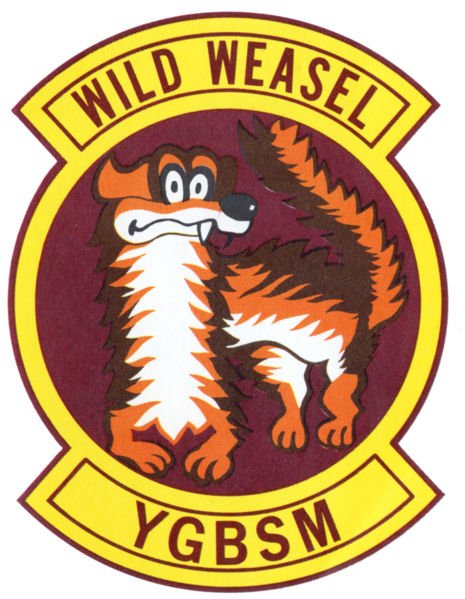
Omdat ik geen foto’s van 291 tijdens deze periode kon vinden en niemand in de nieuwsgroepen omtrent militaire luchtvaart mij er
verder over kon inlichten, nam ik de vrijheid zelf ergens een stukje artwork in te scannen en op decalvel te printen. Zodoende
draagt dit model de naam “Thunderchicken” onder de bakboordsluchtinlaat. De “echte” Thunderchicken was evenwel een F-106A Delta
Dart...
As I could not find any images of 291 during this timeframe and no-one in rec.aviation.military could offer further information,
I took the liberty of scanning a piece of nose art and printing it on clear decal stock. That's how this model came to wear the
name "Thunderchicken" beneath the port inlet. I found the real Thunderchicken artwork on an F-106 Delta Dart...
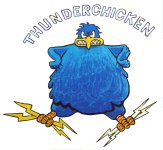
Het toestel met RU als tailcode is dezelfde F-105F, ditmaal in oktober 1968, terug gestationeerd te Takhli en nu resorterend
onder het 357th TFS "Licking Dragons", 355th TFW. Inmiddels was 291 omgebouwd onder het Combat Martin programma. Slechts dertien
Thunderchiefs werden aldus geconverteerd. Schietstoel en stuurknuppel werden uit de achterste cockpit verwijderd, in de plaats
kwam een omvangrijke Hallicrafters QRC-128 computer die de communicatie tussen vijandelijke vliegtuigen en hun luchtleiding moest storen. Dit moest het
Vietnamese luchtruim een stuk veiliger maken voor de Amerikanen, de Noordvietnamese piloten namen immers zelden of nooit het
initiatief tot een luchtgevecht maar werden altijd door de luchtleiding naar een hinderlaagpositie geleid.
Het storen verliep via de grote bladantenne op de rug van het toestel: in plaats van het signaal gewoonweg te storen werden de vijandelijke uitzendingen heel eenvoudig opgevangen en met een vertraging van een paar tiende seconden opnieuw uitgezonden met een onbegrijpelijk gebrabbel als resultaat. Dat daar toen een computer van een kwart kubieke meter voor nodig was, is iets wat we ons vandaag nog moeilijk kunnen voorstellen: de eenvoudigste PDA heeft daarvoor vandaag al voldoende capaciteit...
Het grondpersoneel voorzag de achterste canopy algauw van de naam Col. Computer.
Hoedanook, de NSA (National Security Agency) vond het nuttiger om de vijandelijke communicatie verder te kunnen volgen, dus werd het Combat Martin programma reeds na één missie opgedoekt. Niettemin bleven de verbouwde toestellen nog enige maanden in deze configuratie in gebruik als bommenwerper.
Slechts één Combat Martin toestel (63-8337) overleefde de oorlog niet: het werd door het Noordvietnamese luchtdoelgeschut neergehaald.
Naar verluidt kreeg, omwille van het bijzondere geluid van de gestoorde uitzendingen, één van de toestellen de weinig vleiende naam “Fartin’ Martin”. Andermaal was er niemand die me kon vertellen wat het staartnummer was en of Fartin’ Martin ook artwork droeg. Vermits de kans 1 op 13 is dat 291 het toestel in kwestie was, zocht ik een passend prentje (het origineel stond op een Britse Jaguar die tijdens de eerste Golfoorlog de stripfiguur Johnny Fartpants op z'n neus had staan), kuiste het een beetje op (digitaal, welteverstaan), zette er de naam bij en maakte opnieuw een custom decal.
Het storen verliep via de grote bladantenne op de rug van het toestel: in plaats van het signaal gewoonweg te storen werden de vijandelijke uitzendingen heel eenvoudig opgevangen en met een vertraging van een paar tiende seconden opnieuw uitgezonden met een onbegrijpelijk gebrabbel als resultaat. Dat daar toen een computer van een kwart kubieke meter voor nodig was, is iets wat we ons vandaag nog moeilijk kunnen voorstellen: de eenvoudigste PDA heeft daarvoor vandaag al voldoende capaciteit...
Het grondpersoneel voorzag de achterste canopy algauw van de naam Col. Computer.
Hoedanook, de NSA (National Security Agency) vond het nuttiger om de vijandelijke communicatie verder te kunnen volgen, dus werd het Combat Martin programma reeds na één missie opgedoekt. Niettemin bleven de verbouwde toestellen nog enige maanden in deze configuratie in gebruik als bommenwerper.
Slechts één Combat Martin toestel (63-8337) overleefde de oorlog niet: het werd door het Noordvietnamese luchtdoelgeschut neergehaald.
Naar verluidt kreeg, omwille van het bijzondere geluid van de gestoorde uitzendingen, één van de toestellen de weinig vleiende naam “Fartin’ Martin”. Andermaal was er niemand die me kon vertellen wat het staartnummer was en of Fartin’ Martin ook artwork droeg. Vermits de kans 1 op 13 is dat 291 het toestel in kwestie was, zocht ik een passend prentje (het origineel stond op een Britse Jaguar die tijdens de eerste Golfoorlog de stripfiguur Johnny Fartpants op z'n neus had staan), kuiste het een beetje op (digitaal, welteverstaan), zette er de naam bij en maakte opnieuw een custom decal.
The one toting RU on its tail is the same F-105F, depicted this time in October 1968, again stationed at Takhli and serving with
the 357th TFS "Licking Dragons" - 355th TFW. By then 291 had undergone a conversion under the Combat Martin program. Only 13
Thunderchiefs where modified that way. Ejection seat and control column were removed from the rear cockpit, the room vacated
being taken by a rather large Hallicrafters QRC-128 computer. This device was intended to disrupt the communications between the
enemy aircraft and their Ground Controlled Intercept command posts on the ground. This supposedly would make Vietnamese skies a
lot safer for the Americans, as the North Vietnamese pilots seldom took the initiative to a dogfight - mostly they were directed
to an ambush position from the ground.
The jamming was done by means of a large blade antenna on the spine of the aircraft. Instead of the usual noise jamming the communications were received by the computer, and then retransmitted with a delay of a few tenths of a second, resulting in an incomprehensible garble. To think that this required (in those days) a computer the size of an ejection seat is something that today we find hard to imagine. Today a mere PDA or cell phone would probably be up to the task...
It didn't take very long before ground crews began to put the name "Colonel Computer" on the rear canopy rails.
Anyhow, the National Security Agency thought it more useful to be able to continue listening in on the enemy transmissions, so the Combat Martin program was cancelled after only one mission flown. The modified airframes nevertheless soldiered on in the bomber role.
Only one Combat Martin aircraft didn't survive the war: it got shot down by North Vietnamese anti-aircraft artillery.
Rumour has it that because of the peculiar noise of the jammed communications, one of the aircraft received the not so flattering (flatulent would be a more befitting expression) name of "Fartin' Martin". Again no-one could tell me whether Fartin' Martin wore artwork or what his tail number was. As there's a one in 13 chance of 291 being the plane in question, I searched for a fitting image and found it on the nose of a British Jaguar. During the first Gulf war, that Jaguar sported the cartoon character Johnny Fartpants on it's nose. I cleaned up the image (digitally that is), added the name and printed another custom decal.
The jamming was done by means of a large blade antenna on the spine of the aircraft. Instead of the usual noise jamming the communications were received by the computer, and then retransmitted with a delay of a few tenths of a second, resulting in an incomprehensible garble. To think that this required (in those days) a computer the size of an ejection seat is something that today we find hard to imagine. Today a mere PDA or cell phone would probably be up to the task...
It didn't take very long before ground crews began to put the name "Colonel Computer" on the rear canopy rails.
Anyhow, the National Security Agency thought it more useful to be able to continue listening in on the enemy transmissions, so the Combat Martin program was cancelled after only one mission flown. The modified airframes nevertheless soldiered on in the bomber role.
Only one Combat Martin aircraft didn't survive the war: it got shot down by North Vietnamese anti-aircraft artillery.
Rumour has it that because of the peculiar noise of the jammed communications, one of the aircraft received the not so flattering (flatulent would be a more befitting expression) name of "Fartin' Martin". Again no-one could tell me whether Fartin' Martin wore artwork or what his tail number was. As there's a one in 13 chance of 291 being the plane in question, I searched for a fitting image and found it on the nose of a British Jaguar. During the first Gulf war, that Jaguar sported the cartoon character Johnny Fartpants on it's nose. I cleaned up the image (digitally that is), added the name and printed another custom decal.
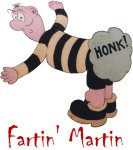
Nummer drie stelt 291 voor in 1972 toen deze reeds omgebouwd was naar F-105G standaard. De G-versie werd vrijwel uitsluitend in
de Wild Weasel rol gebruikt. Intussen was 291 toegewezen aan het 17th WWS (Wild Weasel Squadron), 388th TFW gestationeerd te
Korat, Thailand en draagt JB als tailcode. Tijdens die periode droeg 291 de naam “Mutley, the flying Dog”, geïnspireerd op de
toenmalige tekenfilmserie Wacky Races waarin Mutley de viervoetige kompaan met het slechte karakter was van een al even snode
Dick Dastardly...
Number three shows 291 during 1972 when it was already converted to F-105G standard. The G version was used almost exclusively in
the Wild Weasel role. By then 291 was assigned to the 17th WWS - 388th TFW at Korat RTAB and was wearing the tailcode JB. During
that timeframe 291 sported the name "Mutley, the flying Dog", inspired on the "Wacky Races" cartoon series of that era. In that
series Mutley is the four legged companion with a bad attitude to the equally nefarious Dick Dastardly...
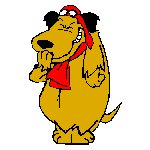
291 overleefde de Vietnam oorlog en vloog in de jaren 70 en 80 nog vele missies in de VS alvorens de laatste Thunderchief in
1986 uit dienst werd genomen. Van deze periode vond ik omtrent 291 geen verdere informatie, zoniet had ik wellicht nog een vierde
model gebouwd...
Uiteindelijk is het toestel tot schroot verwerkt. Een oneervol einde na zo'n fraaie carrière.
Ik beleefde veel plezier aan het bouwen van deze kits. Goed gedetailleerd, past prima en slechts een paar gietputjes hier en daar. Zo goed als geen flash, en er was nauwelijks putty nodig. Zoals te verwachten van een kit uit de jaren tachtig zijn de paneellijnen opliggend, maar dat stoort me niet echt. Mijn enige negatieve commentaar betreft de verstevigingsplaten welke op boven- en onderzijde van de vleugels voorkomen. Deze zijn zo overdreven dat het eerder dikke pantserplaten lijken. Ik heb ze eenvoudigweg afgeschaafd.
De decals in de Monogram kit zijn niets waard, ik verving ze door een aftermarket vel. De Revell USA kit heeft wèl goede decals, maar heel weinig stencilling. De Revel Germany kit daarentegen komt met een decalvel dat je moet zien om te geloven: meer dan 300 decals van de beste kwaliteit, voornamelijk stenciling, met opties voor maar liefst vijf verschillende toestellen. Bravo Revell!
Tijdens het bouwen leek het me dat de neuskegel niet de juiste vorm had, eerder recht dan spitsboogvormig, dus besloot ik er iets aan te doen. De top van de neuskegel werd opgevuld met een pasta die ik maakte van stukjes sprue en aceton, om daarna in de juiste vorm geschuurd te worden. Zonder de minste twijfel omtrent mijn slaagkansen vulde ik meteen alledrie de neuskegels met m'n zelfgemaakte plasticplasticine. Na een paar dagen was de pasta nog niet uitgehard, in plaats daarvan was de punt van de neuskegels zacht geworden. Helemaal niet bezorgd liet ik de kegels een paar weken opzijstaan. Helaas werd de zaak er niet beter op. Ik schreef Revell Duitsland in alle nederigheid dat ik maar liefst drie neuskegels naar de Filistijnen had geholpen, en vroeg hen of ik drie nieuwe kegels kon kopen. Drie weken later bracht de postbode me een klein doosje met daarin gratis drie nieuwe kegels! Dàt is pas klantenservice! Heel, heel erg bedankt Revell!
Voor de eerste maal in al mijn modelbouwersjaren gebruikte ik een paar Black Box cockpit sets. Dat bleek nog lastig om alles te doen passen. Hier en daar moest ik (letterlijk) een hoekje afsnijden of een compromisje sluiten. Eenmaal geschilderd - nog zo'n langdradig karweitje - en gemonteerd ziet je model er wel een stukje fraaier uit. Of het resultaat het extra geld en de inspanning waard is, daarover wordt nog gedelibereerd...
Nog een aftermarket item zijn de witmetalen wielpoten. Hier en daar had ik gelezen of gehoord dat het plastic onderstel van de kit het zou begeven onder het gewicht van het model, en een resin cockpit zou de kit zeker niet lichter maken! Die metalen wielpoten lijken mij doodgewoon afgietsels van de plastic kitonderdelen te zijn. Het zijn exacte kopijen, maar minder scherp afgelijnd dan de originelen.
Uiteindelijk is het toestel tot schroot verwerkt. Een oneervol einde na zo'n fraaie carrière.
Ik beleefde veel plezier aan het bouwen van deze kits. Goed gedetailleerd, past prima en slechts een paar gietputjes hier en daar. Zo goed als geen flash, en er was nauwelijks putty nodig. Zoals te verwachten van een kit uit de jaren tachtig zijn de paneellijnen opliggend, maar dat stoort me niet echt. Mijn enige negatieve commentaar betreft de verstevigingsplaten welke op boven- en onderzijde van de vleugels voorkomen. Deze zijn zo overdreven dat het eerder dikke pantserplaten lijken. Ik heb ze eenvoudigweg afgeschaafd.
De decals in de Monogram kit zijn niets waard, ik verving ze door een aftermarket vel. De Revell USA kit heeft wèl goede decals, maar heel weinig stencilling. De Revel Germany kit daarentegen komt met een decalvel dat je moet zien om te geloven: meer dan 300 decals van de beste kwaliteit, voornamelijk stenciling, met opties voor maar liefst vijf verschillende toestellen. Bravo Revell!
Tijdens het bouwen leek het me dat de neuskegel niet de juiste vorm had, eerder recht dan spitsboogvormig, dus besloot ik er iets aan te doen. De top van de neuskegel werd opgevuld met een pasta die ik maakte van stukjes sprue en aceton, om daarna in de juiste vorm geschuurd te worden. Zonder de minste twijfel omtrent mijn slaagkansen vulde ik meteen alledrie de neuskegels met m'n zelfgemaakte plasticplasticine. Na een paar dagen was de pasta nog niet uitgehard, in plaats daarvan was de punt van de neuskegels zacht geworden. Helemaal niet bezorgd liet ik de kegels een paar weken opzijstaan. Helaas werd de zaak er niet beter op. Ik schreef Revell Duitsland in alle nederigheid dat ik maar liefst drie neuskegels naar de Filistijnen had geholpen, en vroeg hen of ik drie nieuwe kegels kon kopen. Drie weken later bracht de postbode me een klein doosje met daarin gratis drie nieuwe kegels! Dàt is pas klantenservice! Heel, heel erg bedankt Revell!
Voor de eerste maal in al mijn modelbouwersjaren gebruikte ik een paar Black Box cockpit sets. Dat bleek nog lastig om alles te doen passen. Hier en daar moest ik (letterlijk) een hoekje afsnijden of een compromisje sluiten. Eenmaal geschilderd - nog zo'n langdradig karweitje - en gemonteerd ziet je model er wel een stukje fraaier uit. Of het resultaat het extra geld en de inspanning waard is, daarover wordt nog gedelibereerd...
Nog een aftermarket item zijn de witmetalen wielpoten. Hier en daar had ik gelezen of gehoord dat het plastic onderstel van de kit het zou begeven onder het gewicht van het model, en een resin cockpit zou de kit zeker niet lichter maken! Die metalen wielpoten lijken mij doodgewoon afgietsels van de plastic kitonderdelen te zijn. Het zijn exacte kopijen, maar minder scherp afgelijnd dan de originelen.
291 survived the Vietnam War en flew many a mission stateside during the seventies and eighties before the last Thunderchief got
phased out in 1986. I could not find any info on 291's whereabouts during that timeframe. Otherwise I might have built a fourth
model...
Eventualy the plane was scrapped. Truly a dishonorable end to such a glorious carreer.
I really enjoyed this build. The kit is very well detailed, fit is excellent with only a few sink marks here and there. Virtually no flash. I rarely had need for any putty. As to be expected from a kit from the eighties, panel lines are raised, but that doesn't really bother me. My only negative comment concerns the reinforcement plates on the wings' upper and lower sides. These are overdone to an extent that they resemble armour plating. I ended up shaving them of.
The decals in the Monogram issue of this kit are, quite frankly, lousy and had to be replaced with aftermarket ones. The Revel USA issue has good decals, but very little in the way of stencilling. In contrast, the Revell of Germany issue has a decal sheet you need to see to believe: over 300 decals of the best quality, mostly stencilling, and with options to build five different aircraft! Bravo Revell!
During construction I imagined that the nose cone did not have the exact shape, not being the least bit ogival. So I decided to do something about it. I filled the inside of the nosecone tip with a paste I made from sprue and acetone in order to grind the cone to a more ogival shape. Not having the least of doubts that I would succeed, I filled al three nosecones with this homemade concoction. A few days later the paste hadn't hardened, the tip of all three nose cones had softened instead. Not the least bit worried, I let it sit for a few weeks. Unfortunately things didn't got any better. I humbly wrote Revell of Germany saying I screwed up big time, and asked if they could sell me three new nosecones. Three weeks later the mailman brought me a small box with the new cones free of charge! Now that's what I call service. A very big thank you, Revell!!!
For the first time in my modelling career I used Black Box cockpit sets. It proved to be very laborious to make everything fit. I had to cut some corners here and there and make the odd compromise. Once painted up - another laborious task! - it does make for a better model. Whether the result is worth the extra money and effort the jury 's still out on this...
Another aftermarket item used is the white metal landing gear. I read and heard several stories of the kit's plastic gear collapsing under the weight of the kit, and using resin cockpit tubs wasn't going to make the kit any lighter! These metal main gear legs are simply cast from the original plastic ones I think. They are exact copies, although less crisp then their plastic originals.
Eventualy the plane was scrapped. Truly a dishonorable end to such a glorious carreer.
I really enjoyed this build. The kit is very well detailed, fit is excellent with only a few sink marks here and there. Virtually no flash. I rarely had need for any putty. As to be expected from a kit from the eighties, panel lines are raised, but that doesn't really bother me. My only negative comment concerns the reinforcement plates on the wings' upper and lower sides. These are overdone to an extent that they resemble armour plating. I ended up shaving them of.
The decals in the Monogram issue of this kit are, quite frankly, lousy and had to be replaced with aftermarket ones. The Revel USA issue has good decals, but very little in the way of stencilling. In contrast, the Revell of Germany issue has a decal sheet you need to see to believe: over 300 decals of the best quality, mostly stencilling, and with options to build five different aircraft! Bravo Revell!
During construction I imagined that the nose cone did not have the exact shape, not being the least bit ogival. So I decided to do something about it. I filled the inside of the nosecone tip with a paste I made from sprue and acetone in order to grind the cone to a more ogival shape. Not having the least of doubts that I would succeed, I filled al three nosecones with this homemade concoction. A few days later the paste hadn't hardened, the tip of all three nose cones had softened instead. Not the least bit worried, I let it sit for a few weeks. Unfortunately things didn't got any better. I humbly wrote Revell of Germany saying I screwed up big time, and asked if they could sell me three new nosecones. Three weeks later the mailman brought me a small box with the new cones free of charge! Now that's what I call service. A very big thank you, Revell!!!
For the first time in my modelling career I used Black Box cockpit sets. It proved to be very laborious to make everything fit. I had to cut some corners here and there and make the odd compromise. Once painted up - another laborious task! - it does make for a better model. Whether the result is worth the extra money and effort the jury 's still out on this...
Another aftermarket item used is the white metal landing gear. I read and heard several stories of the kit's plastic gear collapsing under the weight of the kit, and using resin cockpit tubs wasn't going to make the kit any lighter! These metal main gear legs are simply cast from the original plastic ones I think. They are exact copies, although less crisp then their plastic originals.
De neuswielpoot had voldoende detail naar mijn mening, ik heb enkel het A-frame opengewerkt.
The nose gear showed enough detail for me, I just opened up the A-frame.
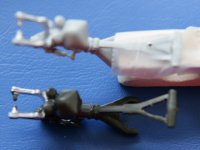
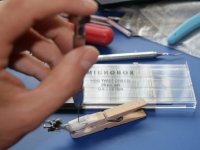
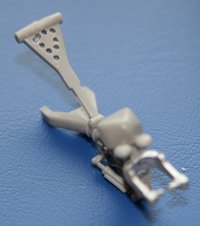

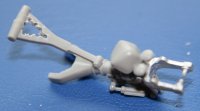
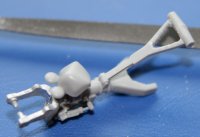
Slechts éénmaal (bij m'n OA-4M Skyhawk) deed ik een poging tot pre-shading, en het resultaat heeft me aangemoedigd om het nog eens
te proberen. Ik ben erg tevreden met het resultaat, hoewel de foto's het model niet volledig recht doen. Het is echt een eenvoudige
techniek, er is enkel wat extra werk en een (min of meer) vaste hand mee gemoeid. Ik ben zinnens deze techniek vaker te gebruiken
wanneer het van pas komt.
En à propos: die scherp afgelijnde Vietnam camouflage vraagt heel wat afplakwerk...
En à propos: die scherp afgelijnde Vietnam camouflage vraagt heel wat afplakwerk...
Only once (on my OA-4M Skyhawk) did I try my hand at pre-shading, and the result encouraged me to have another try at it. I'm very
satisfied with how it turned out, although the pictures don't do justice to the real model... It really is a rather simple
technique, all it involves is some extra work and a (more or less) steady hand. Where applicable, I intend to use this technique
more often.
And by the way: this hard-edged SEA-camouflage requires a lot of masking...
And by the way: this hard-edged SEA-camouflage requires a lot of masking...
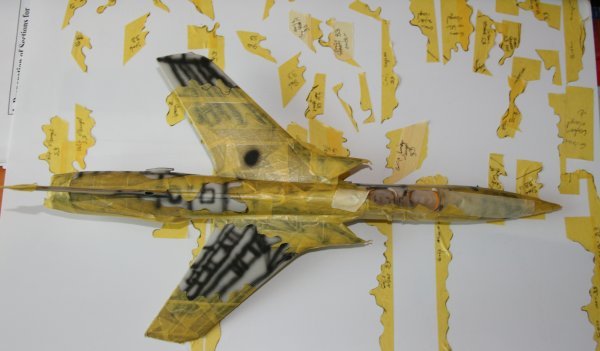
Data
Kit: Monogram 5806, Revell 6868 and Revell 04504Glue: mainly cyano and Micro Weld. White glue for the clear parts.
Putty and masking tape from Tamiya.
Decals: from the kit, Aeromaster 48-675, Superscale 48-324 and some custom made decals
Cockpit: Black Box 48015 (two sets)
Main landing gear: Aeroclub V153
Paint: Humbrol enamels 147,116, 117, 118 and Alclad metalizers. Artist's oil paints for the cockpit.
Sealing: Johnson's Future.
Airbrush: Badger 150
Wash: artist's oil paints thinned with turpentine.
Weathering: artists chalks and pencils.
Varnish: Revell Matt
Documentation: F-105 Thunderchief in detail and scale, Bert Kinzey / Warbirds Illustrated 49, Robert F. Dorr / F-105 Thunderchief, Kev Darling / Modern Combat Aircraft 10, J.C. Scutts / F-105 Thunderchief in action, Lou Drendel / F-105 Thunderchief in action, 2nd edition, Ken Neubeck / Republic F-105 Thunderchief, David Anderton / Thud, Lou Drendel / Walk Around F-105Thunderchief, Ken Neubeck / F-105 Thunderchief - Workhorse of the Vietnam war, Dennis R. Jenkins / Republic F-105 Thunderchief, Larry Davis & David Menard also articles in several other books. The internet and newsgoup rec.aviation.military. Thanks to Ed Rasimus, USAF fighter pilot (retired) and Tex Houston for their input.
Steven De Mulder


